Lycopene overproduction in Saccharomyces cerevisiae through combining pathway engineering with host engineering
- PMID: 27329233
- PMCID: PMC4915043
- DOI: 10.1186/s12934-016-0509-4
Lycopene overproduction in Saccharomyces cerevisiae through combining pathway engineering with host engineering
Abstract
Background: Microbial production of lycopene, a commercially and medically important compound, has received increasing concern in recent years. Saccharomyces cerevisiae is regarded as a safer host for lycopene production than Escherichia coli. However, to date, the lycopene yield (mg/g DCW) in S. cerevisiae was lower than that in E. coli and did not facilitate downstream extraction process, which might be attributed to the incompatibility between host cell and heterologous pathway. Therefore, to achieve lycopene overproduction in S. cerevisiae, both host cell and heterologous pathway should be delicately engineered.
Results: In this study, lycopene biosynthesis pathway was constructed by integration of CrtE, CrtB and CrtI in S. cerevisiae CEN.PK2. When YPL062W, a distant genetic locus, was deleted, little acetate was accumulated and approximately 100 % increase in cytosolic acetyl-CoA pool was achieved relative to that in parental strain. Through screening CrtE, CrtB and CrtI from diverse species, an optimal carotenogenic enzyme combination was obtained, and CrtI from Blakeslea trispora (BtCrtI) was found to have excellent performance on lycopene production as well as lycopene proportion in carotenoid. Then, the expression level of BtCrtI was fine-tuned and the effect of cell mating types was also evaluated. Finally, potential distant genetic targets (YJL064W, ROX1, and DOS2) were deleted and a stress-responsive transcription factor INO2 was also up-regulated. Through the above modifications between host cell and carotenogenic pathway, lycopene yield was increased by approximately 22-fold (from 2.43 to 54.63 mg/g DCW). Eventually, in fed-batch fermentation, lycopene production reached 55.56 mg/g DCW, which is the highest reported yield in yeasts.
Conclusions: Saccharomyces cerevisiae was engineered to produce lycopene in this study. Through combining host engineering (distant genetic loci and cell mating types) with pathway engineering (enzyme screening and gene fine-tuning), lycopene yield was stepwise improved by 22-fold as compared to the starting strain. The highest lycopene yield (55.56 mg/g DCW) in yeasts was achieved in 5-L bioreactors. This study provides a good reference of combinatorial engineering of host cell and heterologous pathway for microbial overproduction of pharmaceutical and chemical products.
Keywords: Heterologous pathway; Lycopene; Metabolic engineering; Saccharomyces cerevisiae; Synthetic biology.
Figures
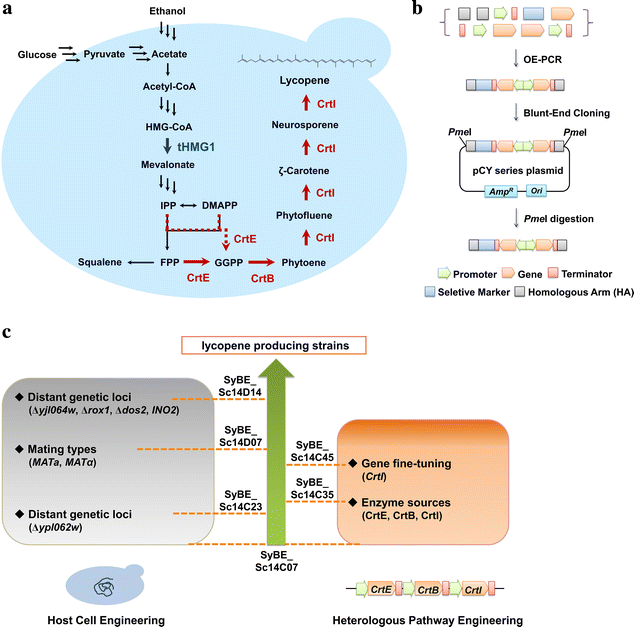

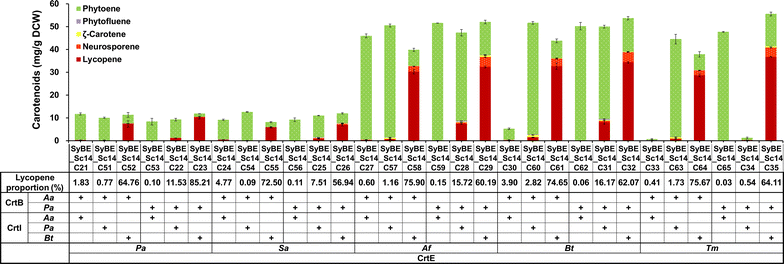
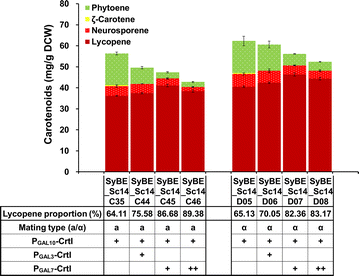
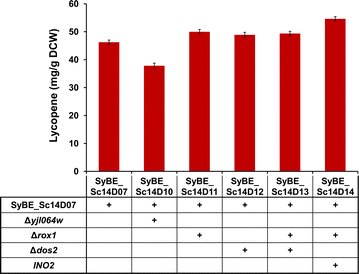
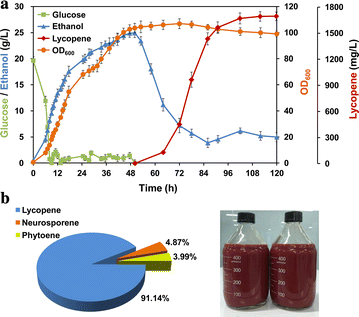
Similar articles
-
Systematic Metabolic Engineering of Saccharomyces cerevisiae for Lycopene Overproduction.J Agric Food Chem. 2019 Oct 9;67(40):11148-11157. doi: 10.1021/acs.jafc.9b04519. Epub 2019 Sep 30. J Agric Food Chem. 2019. PMID: 31532654
-
Efficient production of lycopene in Saccharomyces cerevisiae by enzyme engineering and increasing membrane flexibility and NAPDH production.Appl Microbiol Biotechnol. 2019 Jan;103(1):211-223. doi: 10.1007/s00253-018-9449-8. Epub 2018 Oct 20. Appl Microbiol Biotechnol. 2019. PMID: 30343427
-
Construction of lycopene-overproducing Saccharomyces cerevisiae by combining directed evolution and metabolic engineering.Metab Eng. 2015 Jul;30:69-78. doi: 10.1016/j.ymben.2015.04.009. Epub 2015 May 8. Metab Eng. 2015. PMID: 25959020
-
Metabolic engineering for the production of carotenoids in non-carotenogenic bacteria and yeasts.J Biotechnol. 1997 Jan 3;59(3):169-81. doi: 10.1016/s0168-1656(97)00154-5. J Biotechnol. 1997. PMID: 9519479 Review.
-
Progress on molecular breeding and metabolic engineering of biosynthesis pathways of C(30), C(35), C(40), C(45), C(50) carotenoids.Biotechnol Adv. 2007 May-Jun;25(3):211-22. doi: 10.1016/j.biotechadv.2006.12.001. Epub 2006 Dec 19. Biotechnol Adv. 2007. PMID: 17257797 Review.
Cited by
-
Genome-wide CRISPR-Cas9 screen reveals a persistent null-hyphal phenotype that maintains high carotenoid production in Yarrowia lipolytica.Biotechnol Bioeng. 2022 Dec;119(12):3623-3631. doi: 10.1002/bit.28219. Epub 2022 Sep 22. Biotechnol Bioeng. 2022. PMID: 36042688 Free PMC article.
-
Ustilago maydis Serves as a Novel Production Host for the Synthesis of Plant and Fungal Sesquiterpenoids.Front Microbiol. 2020 Jul 24;11:1655. doi: 10.3389/fmicb.2020.01655. eCollection 2020. Front Microbiol. 2020. PMID: 32849341 Free PMC article.
-
Focus and Insights into the Synthetic Biology-Mediated Chassis of Economically Important Fungi for the Production of High-Value Metabolites.Microorganisms. 2023 Apr 27;11(5):1141. doi: 10.3390/microorganisms11051141. Microorganisms. 2023. PMID: 37317115 Free PMC article. Review.
-
Prospective bacterial and fungal sources of hyaluronic acid: A review.Comput Struct Biotechnol J. 2022 Nov 10;20:6214-6236. doi: 10.1016/j.csbj.2022.11.013. eCollection 2022. Comput Struct Biotechnol J. 2022. PMID: 36420162 Free PMC article. Review.
-
Modular engineering for microbial production of carotenoids.Metab Eng Commun. 2019 Dec 15;10:e00118. doi: 10.1016/j.mec.2019.e00118. eCollection 2020 Jun. Metab Eng Commun. 2019. PMID: 31908924 Free PMC article. Review.
References
-
- Trikka FA, Nikolaidis A, Athanasakoglou A, Andreadelli A, Ignea C, Kotta K, Argiriou A, Kampranis SC, Makris AM. Iterative carotenogenic screens identify combinations of yeast gene deletions that enhance sclareol production. Microb Cell Fact. 2015;14:60. doi: 10.1186/s12934-015-0246-0. - DOI - PMC - PubMed
MeSH terms
Substances
LinkOut - more resources
Full Text Sources
Other Literature Sources
Molecular Biology Databases

